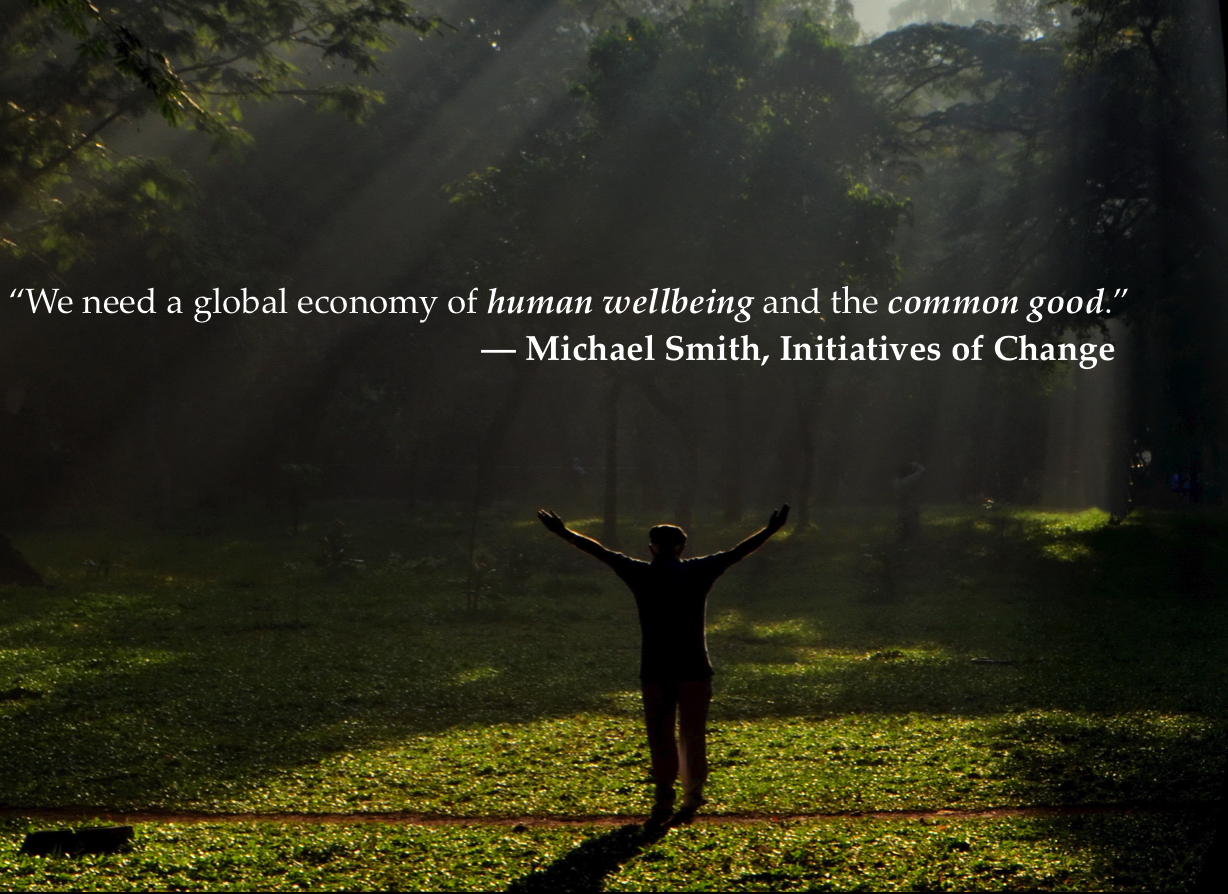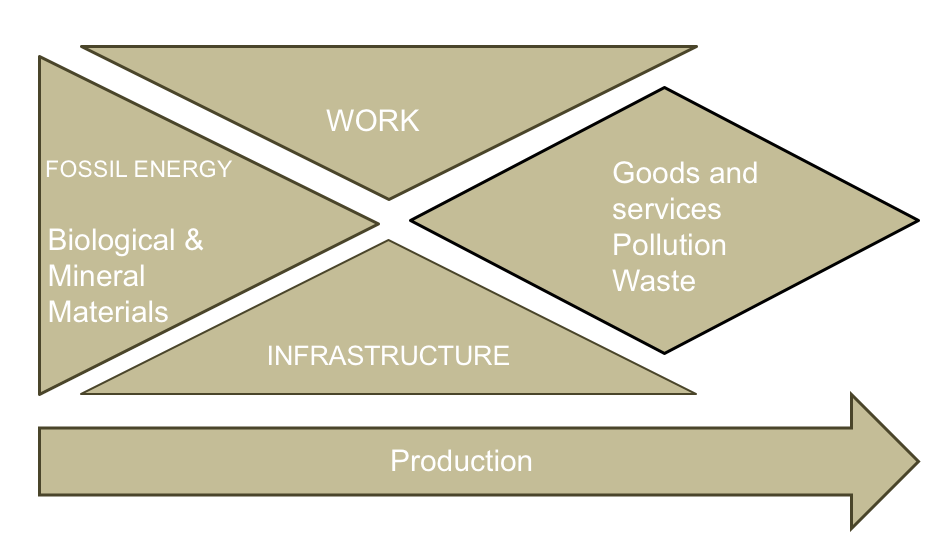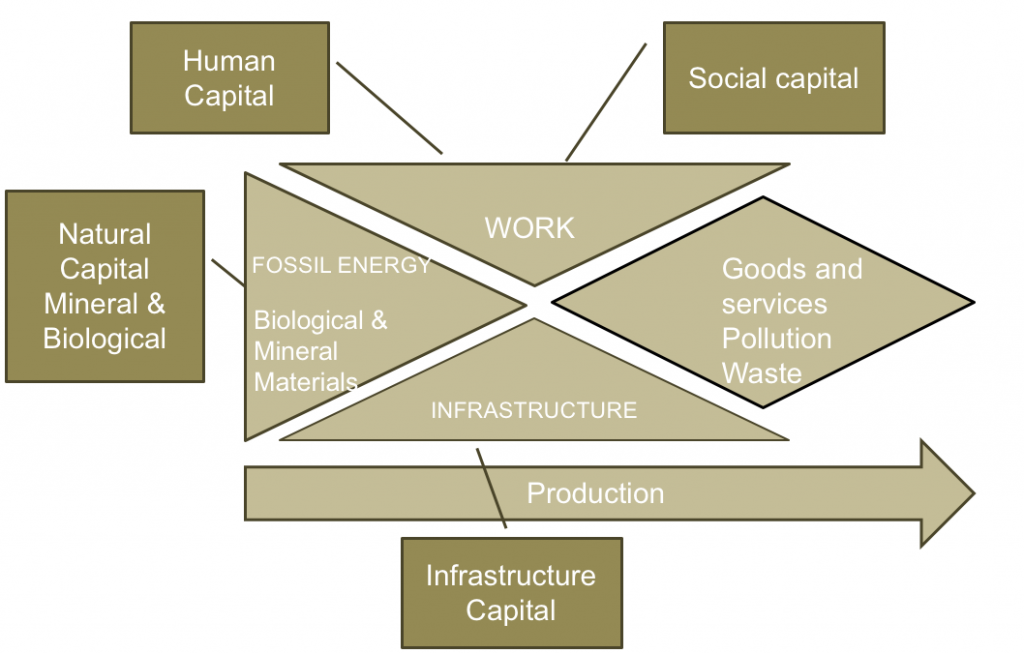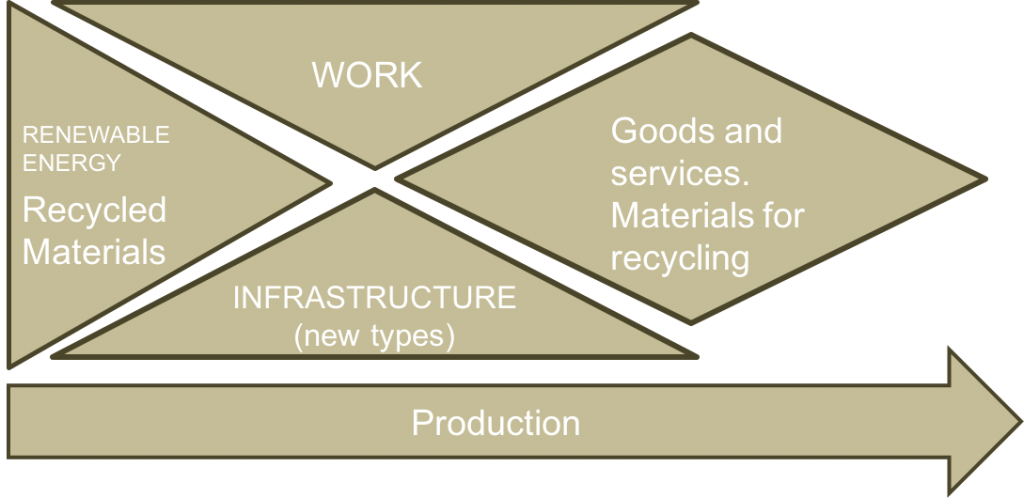As world population expands, and the demand for a better standard of living drives the world economy, it is becoming clearer to many that using up the world’s resources will actually put us at risk of ending up with a lower standard of living. It could even drive conflicts. Insecurity and lack of the capability to produce the basics are likely to fan the flames of conflict and undermine peace in the world. We urgently need a new mindset – one that focusses on bringing security of the basics to everyone whilst preserving and indeed increasing the capability of society to provide.
Part of this new mindset requires us to rethink capital. This article breaks down the importance of capital to society, and how the economy should manage capital if we are to transition to a sustainable and peaceful future.
How firms work and their need for capital
The stuff our society produces, and the things used to provide services that make up our standard of living come from firms. These all have a similar set-up, even if some are for profit and others are publicly run. The diagram below shows the basic pattern.
Products or services come from the organizations as a result of work by staff at the organization using the infrastructure comprising buildings, machines and tools.
On the left of the diagram, work and infrastructure get inputs of energy and materials, biological and mineral materials. On the right side, the firm produces products and services. Apart from products there are outputs in the form of waste.
In terms of inputs there are things that are used up – energy and other materials. Things that are used but not used up – things like the buildings, tools and machines, it is these things we call capital – infrastructure capital.
CAPITAL ˈkapɪt(ə)l/ : Assets used, but not used up, in the production of goods and services.
Capital is a term used for things that are used, but not used up. This is important for investing in peace as we will see later. Things that organizations own or have the right to use are important items as assets on their balance sheets, whereas inputs are classed as expenses.
There are four kinds of capital
- Infrastructure capital – like buildings and tools and equipment
- Social capital – includes organizations, processes and know-how embedded in the organization
- Human capital – this is the levels of skills and knowledge of the people involved in the organization
- Natural capital – comprises eco-systems from which biological material is harvested to provide input to the firm – wood for building for example – and the mineral resources that are mined to give inputs like copper and steel.
The diagram below shows their significance to the firm.
Real capital vs financial capital
The term Capital can mean money people or organizations have to invest. In business, it represents the money invested in the business. There are two main ways to put money into a business: as stocks and shares (equity) or as loans. What is interesting is that for a firm to produce it has to have some premises, equipment, tools etc in place. So, to acquire real capital -infrastructure– indeed to set a firm up to get it started means you need to acquire financial capital and spend it on infrastructure before you start.
Infrastructure capital in the firm
So where in this explainer does sustainable development come in? The diagram below shows the various components of a firm that runs in a sustainable, circular economy way. This is the new pattern for the firm emerging.
Let us go through the main differences:
Inputs
- For energy inputs fossil-based energy sources are replaced with renewable options
- For material inputs, virgin extracted mineral inputs are replaced with recycled material.
- In terms of biological materials, these are renewable so the main difference is that they have been gathered in a sustainable way.
Infrastructure: types of infrastructure capital
Producing modern infrastructure like tools and equipment requires vast quantities of fossil fuel. However, once in place this infrastructure lasts for many years. So using fossil fuels is better to produce infrastructure than producing it for transport fuel. This brings us to the diagram below that will illustrate the infrastructure technology shift.
Some infrastructure requires a lot of energy to produce. If so, it should be the kind that is used for many years and dos not require a lot of energy to run. Examples of this include hydro power stations and electrified railways. The other type is produced using little energy, used a short time, and easily recycles (as components, basic materials). Things made of basket are good examples of this, the material easily composts into new soil.
On the left side the absolutely worst type of infrastructure is that which requires a lot of energy to produce, and uses a lot of energy over its life-time. The best example of this is the automobile. Some studies show that to produce a car takes as much energy as the car uses over its life-time.
At the bottom left is something that takes little energy to produce but requires a lot of energy over its life time. One example of this type of technology is the oil lamp.
In terms of shift in technical infrastructure capital, to move towards the sustainable enterprise means going from left to right. From a financial perspective it means using money invested in the enterprise to purchase another kind of equipment.
Social and human capital
Social capital comprises organizations that have been set up to provide essential services as well as the rules and processes these run by. You could say that social capital includes institutions and institutional knowledge.
The shift at social capital level is one where organisations are set up in a way to be regenerative: that is to say they do not function by drawing down natural or human resources. The shift required is extensive as most firms today have long, complicated supply chains. They need to ensure that throughout their supply chain the needs of people affected by it are met and nature is treated restoratively. These organizations, then, need to embed the knowledge and skills to function without depleting capital.
At an individual level there is human capital. This represents the knowledge, skills and capabilities people possess. The shift required is one of mindset first. People working in the firm and running it need to understand how regeneration works. You could say that the mindset is one of where the business of business is peace.
Natural Capital
Natural capital represents the biological, hydrological, metrological and mineral systems that the Earth has been endowed with. The essential principle of capital – used but not used up – means that removal of biological material for inputs and their return to eco system is done in a way that does not reduce the functioning of the eco-system. For mineral endowment it means that once extracted the minerals remain useful and can be recycled.
Capital depletion and peace
Producing goods and services in a way that depletes capital – be it human, natural, social or even infrastructure- decreases the capability of others to ensure security of the basics. Without the security of fiber, food and fuel for housing and security, the basic conditions for peace are undermined.
A mindset that depletes capital is often termed extractive, to be contrasted with a regenerative mindset, one that builds up capital.
As can be seen from the table below, a regenerative approach is different for all forms of capital.
| Capital type | Extractive | Regenerative |
| Infrastructure | Short-lasting
Runs only on fossil fuel Cannot handle non-virgin material Produces non- recyclable waste |
Long-lasting
Runs on renewable energy Handles recycled materials Produces no waste |
| Natural | Biomass harvested in a way that depletes eco-system
Biomass returned in a way that pollutes eco-system Minerals extracted made unavailable to be recycled |
Biomass harvested in a way that regenerates eco-system
Biomass returned in a way that regenerates the eco-system Minerals returned to the economy embedded in re-usable products, components or easily recoverable. |
| Social | Set up to replace stimulating rewarding work with repetitive tasks or automation. Little knowledge developed of the regenerative economy among workers or customers.
Contribution to peace unclear |
Provides rewarding work.
Passes on knowledge and skills of the regenerative economy.
Clear contribution to peace along the supply chain from raw material to end of life. |
| Human | Effective production only with stress on workers, customers and society in general | Rewarding for customers, workers and society |
For humanity to realize its project of peace on Earth we need a new mindset that turns away from seeing only money as capital to invest to a stewardship mindset where the other kinds of capital are built up and looked after. This means taking care of nature, natural resources, people and organizations – so that they can be employed to produce at least the basics we need for everyone to have basic security.
FURTHER READING
See the article on accounting in the circular economy





